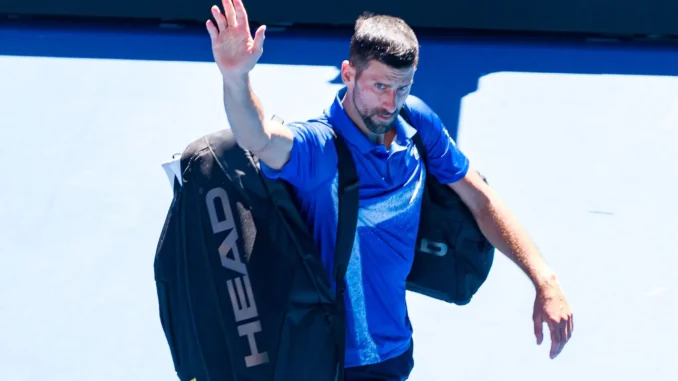
Novak Djokovic’s remarkable ability to recover from injuries has become a recurring theme in his illustrious tennis career, consistently sparking both admiration and, at times, a degree of skepticism. His recent experience with a hamstring injury sustained at the Australian Open has once again placed his resilience under the microscope, igniting conversations about his training regimen, his medical team, and the very nature of athletic recovery.1
Djokovic’s path to recovery has rarely been straightforward. During his quarterfinal match against Carlos Alcaraz at the Australian Open, he visibly experienced discomfort in his left hamstring. Despite the apparent injury, he continued to compete, ultimately securing a victory. However, the strain proved significant enough to force his withdrawal from the subsequent semifinal against Alexander Zverev, leaving many to question the true extent and legitimacy of the injury.
Adding another layer to the narrative, Djokovic later shared an MRI scan of his hamstring on social media, a move seemingly designed to quell any rising doubts about the veracity of his injury.2 This public display of medical information, while intended to offer transparency, only fueled further speculation. Rumors began to circulate regarding his potential return to the court, with some suggesting he wouldn’t be seen in action until the clay court season, months away.
Yet, as has become characteristic of his career, Djokovic defied expectations. He recently announced his participation in the Qatar Open, a clear indication of his near-complete recovery and his readiness to compete at the highest echelons of the sport.3 This rapid turnaround, seemingly contradicting earlier predictions, has reignited the discussions surrounding his training methods, the expertise of his medical support, and perhaps even the possibility of a genetic predisposition that facilitates accelerated healing.
Adding to the ongoing dialogue, Mark Petchey, former coach of Andy Murray, offered his perspective on Djokovic’s swift recovery, cautioning against the unquestioning acceptance of information disseminated online. “Never believe everything you read, especially on the Internet,” Petchey stated, highlighting the pervasive nature of misinformation and conjecture in the digital age, particularly when it comes to high-profile figures like Djokovic. His comment serves as a reminder to approach news and social media narratives with a critical eye, especially in the realm of sports and celebrity culture.
Djokovic’s history of overcoming physical setbacks is well-documented and forms a significant part of his narrative. He has repeatedly demonstrated an almost uncanny ability to bounce back from injuries that would sideline most athletes for extended periods, leaving fans, rivals, and medical professionals alike in a state of awe. Whether it’s recovering from knee surgery to capture an Olympic gold medal or swiftly healing from a muscle tear to compete in a Grand Slam tournament, Djokovic has consistently defied conventional recovery timelines, establishing himself as an outlier in the world of professional sports.
This recurring pattern of rapid recovery has, understandably, led some to question the validity of his reported injuries. There have been whispers, sometimes more than whispers, suggesting that he might be exaggerating the severity of his ailments, strategically downplaying their impact to gain a competitive edge or manipulate public perception. However, Djokovic has consistently maintained that his injuries are genuine, often providing medical evidence to substantiate his claims and refute accusations of deception.
The debate surrounding Djokovic’s injuries and recoveries is unlikely to subside anytime soon. While some will continue to harbor skepticism, questioning the remarkable speed of his healing processes, others will marvel at his resilience, attributing it to a combination of factors, including his unwavering dedication, the expertise of his support team, and perhaps even a touch of good fortune. Regardless of individual opinions, one undeniable truth remains: Djokovic’s ability to recover quickly has become an inseparable part of his narrative, adding another compelling dimension to his already multifaceted story.
In the demanding world of professional sports, where athletes constantly push their bodies to the absolute limits of human capability, injuries are an unavoidable occupational hazard. However, the manner in which athletes respond to and recover from these injuries can vary dramatically. Djokovic’s case stands out precisely because of the sheer speed and frequency of his recoveries, placing him in a category of his own.
While some might attribute his rapid recoveries to mere luck or a series of fortunate coincidences, others believe that a complex interplay of underlying factors contributes to his exceptional healing abilities. These factors could include his meticulously structured training regimen, his unwavering focus on nutrition and recovery protocols, the expertise of his medical and coaching team, and, as some have speculated, perhaps even a genetic predisposition that favors rapid tissue repair and regeneration.
Djokovic’s unwavering commitment to his physical well-being is well-known and often cited as a key element in his success. He adheres to a strict, carefully curated diet, prioritizes sleep as a crucial component of recovery, and incorporates a variety of cutting-edge recovery methods into his daily routine. These practices, meticulously followed and consistently applied, could play a significant role in his ability to heal quickly and effectively from injuries.
Furthermore, the importance of Djokovic’s mental fortitude cannot be overstated. He possesses an almost preternatural belief in his body’s capacity to recover and overcome physical challenges. This positive and unwavering mindset, coupled with his exceptional discipline, could significantly contribute to his healing process. The connection between the mind and body is a powerful and often underestimated force, and Djokovic seems to have mastered the art of harnessing its potential to facilitate his recoveries.
Ultimately, the precise reasons behind Djokovic’s remarkable ability to recover from injuries remain a subject of ongoing speculation and healthy debate. Whether it’s a unique combination of physical conditioning, mental strength, genetic predisposition, or a synergistic effect of all these factors, his capacity to bounce back from setbacks is undeniably extraordinary. As he continues his career, pushing the boundaries of his physical capabilities, his resilience will undoubtedly be tested further, and the world will be watching closely to see how he responds to future challenges, both on and off the court.
Leave a Reply